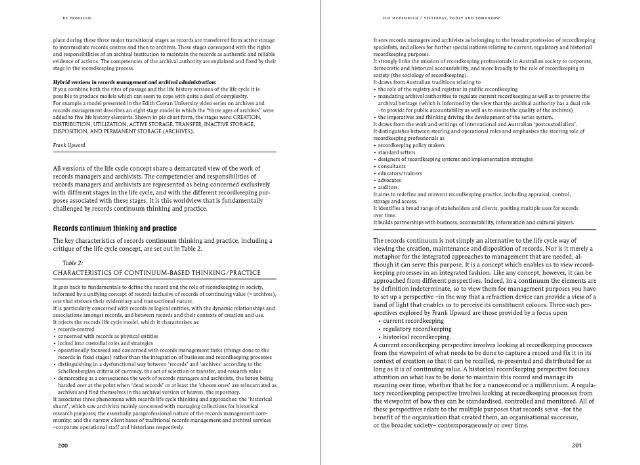All versions of the life cycle concept share a demarcated view of the work of
records managers and archivists. The competencies and responsibilities of
records managers and archivists are represented as being concerned exclusively
with different stages in the life cycle, and with the different recordkeeping pur
poses associated with these stages. It is this worldview that is fundamentally
challenged by records continuum thinking and practice.
Records continuum thinking and practice
The key characteristics of records continuum thinking and practice, including a
critique of the life cycle concept, are set out in Table 2.
Table 2:
CHARACTERISTICS OF CONTINUUM-BASED THINKING/PRACTICE
The records continuum is not simply an alternative to the life cycle way of
viewing the creation, maintenance and disposition of records. Nor is it merely a
metaphor for the integrated approaches to management that are needed, al
though it can serve this purpose. It is a concept which enables us to view record
keeping processes in an integrated fashion. Like any concept, however, it can be
approached from different perspectives. Indeed, in a continuum the elements are
by definition indeterminate, so to view them for management purposes you have
to set up a perspective -in the way that a refraction device can provide a view of a
band of light that enables us to perceive its constituent colours. Three such per
spectives explored by Frank Upward are those provided by a focus upon
current recordkeeping
regulatory recordkeeping
historical recordkeeping.
A current recordkeeping perspective involves looking at recordkeeping processes
from the viewpoint of what needs to be done to capture a record and fix it in its
context of creation so that it can be recalled, re-presented and distributed for as
long as it is of continuing value. A historical recordkeeping perspective focuses
attention on what has to be done to maintain this record and manage its
meaning over time, whether that be for a nanosecond or a millennium. A regula
tory recordkeeping perspective involves looking at recordkeeping processes from
the viewpoint of how they can be standardised, controlled and monitored. All of
these perspectives relate to the multiple purposes that records serve -for the
benefit of the organisation that created them, an organisational successor,
or the broader society- contemporaneously or over time.
DE PROFESSIE
place during these three major transitional stages as records are transferred from active storage
to intermediate records centres and then to archives. These stages correspond with the rights
and responsibilities of an archival institution to maintain the records as authentic and reliable
evidence of actions. The competencies of the archival authority are explained and fixed by their
stage in the recordkeeping process.
Hybrid versions in records management and archival administration:
If you combine both the rites of passage and the life history versions of the life cycle it is
possible to produce models which can seem to cope with quite a deal of complexity.
For example a model presented in the Edith Cowan University video series on archives and
records management describes an eight stage model in which the "three ages of archives" were
added to five life history elements. Shown in pie chart form, the stages were: CREATION,
DISTRIBUTION, UTILIZATION, ACTIVE STORAGE, TRANSFER, INACTIVE STORAGE,
DISPOSITION, AND PERMANENT STORAGE (ARCHIVES).
Frank Upward
It goes back to fundamentals to define the record and the role of recordkeeping in society,
informed by a unifying concept of records inclusive of records of continuing value archives),
one that stresses their evidentiary and transactional nature.
It is particularly concerned with records as logical entities, with the dynamic relationships and
associations amongst records, and between records and their contexts of creation and use.
It rejects the records life cycle model, which it characterises as:
records-centred
concerned with records as physical entities
locked into custodial roles and strategies
operationally focussed and concerned with records management tasks (things done to the
records in fixed stages) rather than the integration of business and recordkeeping processes
distinguishing in a dysfunctional way between 'records' and 'archives' according to the
Schellenbergian criteria of currency, the act of selection or transfer, and research value
demarcating as a consequence the work of records managers and archivists, the baton being
handed over at the point when 'dead records' or at least the 'chosen ones' are reincarnated as
archives and find themselves in the archival version of heaven, the repository.
It associates three phenomena with records life cycle thinking and approaches: the 'historical
shunt', which saw archivists mainly concerned with managing collections for historical
research purposes; the essentially paraprofessional nature of the records management com
munity; and the narrow client bases of traditional records management and archival services
-corporate operational staff and historians respectively.
200
SUE MCKEMMISH YESTERDAY, TODAY AND TOMORROW
It sees records managers and archivists as belonging to the broader profession of recordkeeping
specialists, and allows for further specialisations relating to current, regulatory and historical
recordkeeping purposes.
It strongly links the mission of recordkeeping professionals in Australian society to corporate,
democratic and historical accountability, and more broadly to the role of recordkeeping in
society (the sociology of recordkeeping).
It draws from Australian traditions relating to
the role of the registry and registrar in public recordkeeping
mandating archival authorities to regulate current recordkeeping as well as to preserve the
archival heritage (which is informed by the view that the archival authority has a dual role
-to provide for public accountability as well as to assure the quality of the archives)
the imperatives and thinking driving the development of the series system.
It draws from the work and writings of international and Australian 'postcustodialists'.
It distinguishes between steering and operational roles and emphasises the steering role of
recordkeeping professionals as
recordkeeping policy makers
standard setters
designers of recordkeeping systems and implementation strategies
consultants
educators/trainers
advocates
auditors.
It aims to redefine and reinvent recordkeeping practice, including appraisal, control,
storage and access.
It identifies a broad range of stakeholders and clients, positing multiple uses for records
over time.
It builds partnerships with business, accountability, information and cultural players.
201

